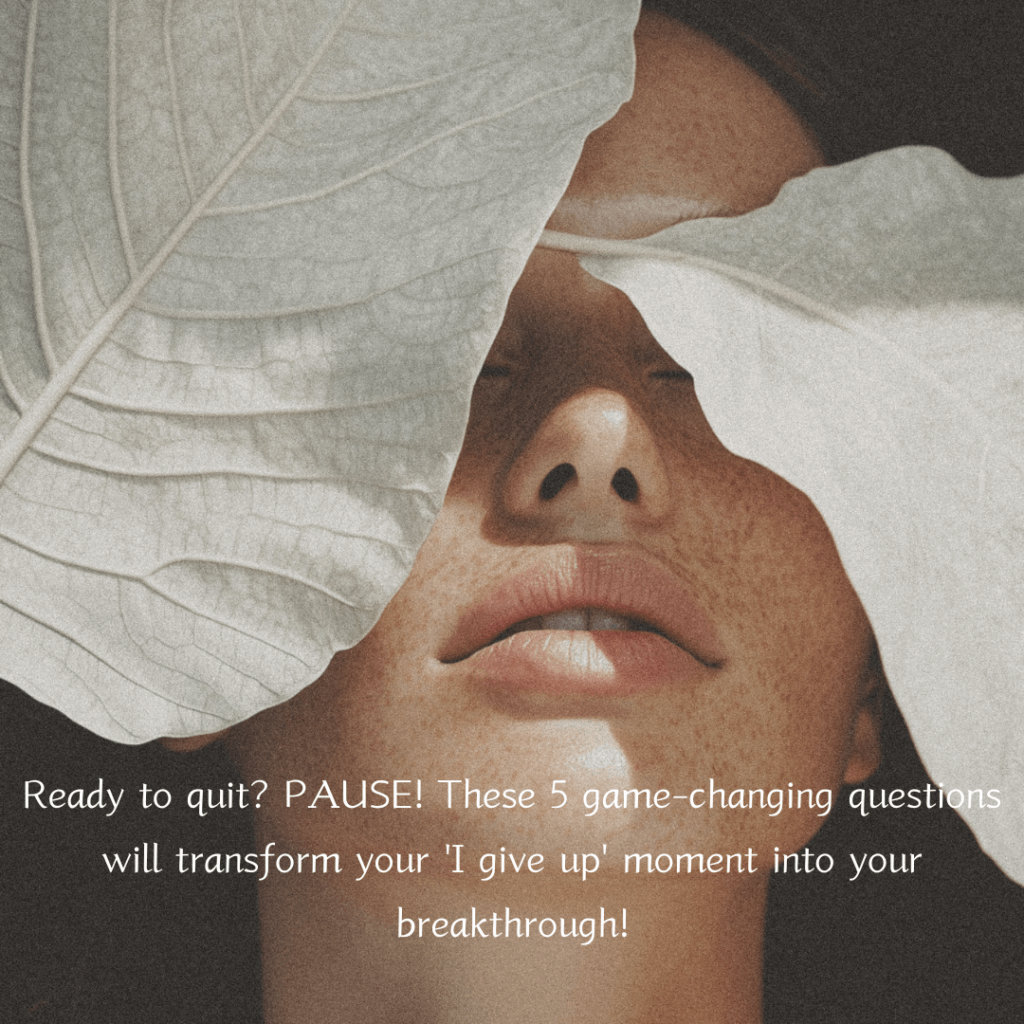When you’re standing at the crossroads of giving up, you’re not just facing a simple yes-or-no decision – you’re encountering a profound moment of transformation. These pivotal moments arrive as teachers, offering you the chance to explore depths of wisdom you didn’t know you possessed. While it’s tempting to make snap decisions based on immediate emotions, the art of asking yourself the right questions can illuminate paths you haven’t yet considered. Your journey forward deserves more than a hasty retreat; it calls for the kind of self-reflection that transforms uncertainty into clarity.

“Strength does not come from physical capacity. It comes from an indomitable will.”
―Mahatma Gandhi
“It always seems impossible until it’s done.”
―Nelson Mandela
Why These Questions Before Giving Up Matter
Almost every pivotal life decision deserves deep reflection before surrendering to defeat. When you’re at a crossroads, contemplating giving up, asking these questions before giving up serve as powerful self-reflection practices that illuminate your path forward. They’re designed to guide you through the fog of uncertainty and reveal truths you might’ve overlooked.
These clarity techniques matter because they prevent impulsive decisions driven by temporary emotions. By engaging in personal growth strategies, you create space between your challenges and your response to them. You’ll discover that what feels like an insurmountable wall might actually be a stepping stone to your evolution.
Through mindset shifts, you begin to see obstacles not as endpoints but as opportunities for transformation. These questions help you distinguish between genuine dead ends and situations that simply require a new approach. They’re your compass for overcoming obstacles, helping you tap into inner wisdom you mightn’t realize you possess.
When you pause to explore these reflections, you honor your journey’s complexity and give yourself the gift of conscious choice rather than reactive surrender.
Essential Questions to Ask Before Giving Up That Transform Your Path
When you’re on the edge of surrendering a dream or goal, you’ll find profound clarity by asking yourself transformative questions that reveal whether you’re truly evolving or simply escaping, what limiting stories you’re believing, and if your choices stem from freedom or fear.
These penetrating inquiries – including what you’d attempt if failure wasn’t possible and what’s genuinely true in this moment – serve as spiritual compass points to illuminate your authentic path forward.

1. Am I Evolving or Escaping?
When you’re contemplating a major life change, it’s essential to distinguish between authentic evolution and mere escape from discomfort.
True growth expands your consciousness while avoidance simply shifts the location of your struggles.
You’ll recognize genuine transformation by your willingness to face challenges head-on, whereas escape patterns often manifest as rushed decisions driven by fear or overwhelm.
Before giving up on a situation, pause to examine whether you’re moving toward something meaningful or running from something unresolved, as this single reflection can illuminate whether you’re on a path of conscious evolution or unconscious avoidance.
Difference between natural growth and avoidance patterns
Life’s changes often mask themselves in ways that can blur the line between genuine evolution and subtle escape tactics.
Natural growth stems from facing challenges with emotional resilience, while avoidance patterns disguise themselves as progress.
Your focus and personal development thrives when you’re moving toward something meaningful, not running away.
True decision-making strategies embrace discomfort as a catalyst for authentic transformation.
Quick reflection on authentic endings vs. reactive patterns
The question “Am I evolving or escaping?” holds profound transformative power in moments of uncertainty.
When facing crossroads, conscious transformation requires distinguishing between authentic closure and reactive tendencies.
You’ll recognize genuine endings through emotional resilience and inner peace, while escape patterns often stem from fear or discomfort.
Mindful decision-making helps you discern whether you’re growing through challenges or avoiding necessary growth work.
Take a moment to reflect on these questions in your journal:
What growth have I experienced through this challenge?
If I stay, what might I learn?
What patterns from my past am I seeing here?
How would walking away serve my evolution?
2. What Story Am I Believing About This?
The stories you tell yourself about challenging situations shape your reality far more than the situations themselves.
When you’re ready to give up, examine whether you’re operating from limiting beliefs (“I’m not capable enough” or “This always happens to me”) rather than objective truth.
Your inner narrative has immense power – by questioning and reframing the stories you believe, you open yourself to new possibilities and perspectives that can transform your path forward.
How our narratives shape our decisions
Personal narratives weave invisible threads through every choice you make, shaping decisions before they even reach conscious awareness.
Your belief systems and self-perception dynamics create powerful filters that influence how you interpret situations and respond to challenges.
Brief look at limiting beliefs vs. truth
At crossroads of challenge, limiting beliefs often masquerade as absolute truths, creating invisible barriers between you and your potential.
Through mindful self-awareness, you’ll discover these perceived limitations are merely stories you’ve accepted.
By questioning your limiting beliefs and embracing transformative truths, you unfasten dormant inner strength.
These mindset shifts reveal the vast landscape of possibilities that’s always existed beyond self-imposed boundaries.
Take a moment to reflect on these questions in your journal:
What’s the story I keep telling myself?
Where did I first learn this narrative?
What would be possible if this story wasn’t true?
What’s a more empowering way to view this situation?
3. Is This Decision Coming From Freedom or Fear?
When you’re at a crossroads, pausing to examine whether your choice stems from freedom or fear can illuminate your true path forward.
You’ll notice that decisions rooted in freedom often expand your potential and align with growth, while fear-based choices typically arise from wanting to avoid discomfort or protect yourself from perceived threats.
Understanding our emotional drivers
Behind every significant choice lies a fundamental battle between two primal forces: freedom and fear.
Your emotional resilience and inner dialogue shape these motivational drivers, creating patterns that either expand or limit your potential.
Through self-awareness practices, you can develop the emotional intelligence to recognize when fear disguises itself as practicality, helping you make choices aligned with authentic growth.
Quick check on whether we’re moving toward growth or away from discomfort
Making conscious choices requires a clear understanding of your inner compass.
Before abandoning your path, pause to examine whether you’re embracing a growth mindset or simply avoiding the discomfort zone.
Through self reflection practices, you’ll recognize if fear is driving your decisions.
True resilience building emerges when you lean into challenges with emotional intelligence, choosing growth over escape.
Take a moment to reflect on these questions in your journal:
What fears are driving my current thoughts?
How would I approach this if I felt completely safe?
What does my heart say when my mind is quiet?
What would choosing freedom look like here?
4. What Would I Do If I Couldn’t Fail?
When you strip away the possibility of failure, your authentic aspirations rise naturally to the surface without resistance or doubt.
Taking a moment to imagine this barrier-free state allows you to glimpse your soul’s true callings and deepest desires, unclouded by fear’s limiting whispers. My advice: write the answer down and read it often!
Removing the fear barrier
Fear often stands as the invisible wall between you and your deepest aspirations. Have you stopped trying? Have you lost focus?
By embracing vulnerability and cultivating self-compassion, you can dismantle this barrier piece by piece.
Effective fear management techniques begin with acknowledging your fears without judgment.
Building resilience isn’t about eliminating fear but transforming it into fuel for growth.
Overcoming self-doubt becomes possible when you face your fears with gentle determination.
Brief exploration of our true desires
Dreams buried beneath layers of practicality often whisper their truth in quiet moments.
When you pause to explore your inner desires, you’ll discover the authentic self yearning to emerge.
Strip away society’s expectations and dive deep into your true motivations – what ignites your soul?
This journey of passion discovery realigns you with your personal values, revealing the path you’re meant to walk.
Take a moment to reflect on these questions in your journal:
What would I attempt if success was guaranteed?
What dreams have I been putting on hold?
What’s the worst that could actually happen?
What’s the best that could happen?
5. What’s Actually True Right Now?
When you’re feeling stuck or ready to give up, pause to notice what’s actually happening in this present moment rather than getting lost in stories about the future.
Your mind may be projecting fears and worst-case scenarios, but bringing your attention to current reality helps distinguish between genuine obstacles and anxious thoughts.
Take a breath and ask yourself “What’s factually true right now?” to ground yourself in the concrete circumstances you’re traversing rather than theoretical problems.
Present moment awareness
The mind often races ahead to imagined futures or dwells in remembered pasts, leaving you disconnected from what’s actually happening now.
Through mindful breathing and moment reflection, you can anchor yourself in present reality.
Engage your senses fully, notice the details around you, and cultivate present gratitude.
These awareness practices help you see truth clearly, free from distortion and projection.
Reality check vs. mental projections
Your mind creates powerful stories about situations, but these narratives often stray far from actual reality.
Through self-reflection techniques, you can separate cognitive distortions from truth by asking: “What’s factually happening right now?”
This reality check builds emotional resilience and mental clarity, helping you make decisions based on what’s real rather than projected fears or assumptions.
Take a moment to reflect on these questions in your journal:
What facts can I state about this situation?
What’s actually working well right now?
What resources and support do I have available?
What’s within my control in this moment?
Moving Forward: Beyond Questions Before Giving Up
As you stand at this crossroads of choice, remember that you’ve always carried an inner compass of wisdom guiding you toward what’s truly right for your path.
You’ll discover that when you quiet the external noise and tune into your heart’s whispers, the answers emerge with surprising clarity.
Trust that your soul’s knowing, combined with mindful reflection, will illuminate the next steps forward – whether that means persisting with renewed purpose or compassionately choosing a new direction.
Empowering reminder about our innate wisdom to choose
Deep within lies an unwavering compass that guides us toward truth and authentic choices. Your inner strength emerges when you acknowledge this innate wisdom, connecting you to a profound source of decision clarity that transcends surface-level thinking.
Through life’s challenges, you’re constantly developing personal resilience, even when you don’t realize it.
On your self-discovery journey, you’ll find that the answers you seek aren’t external – they’re woven into the fabric of your being. When you pause to listen, your inner guidance system illuminates the path forward with remarkable precision.
You’re naturally equipped to make mindful choices that align with your highest good, even in moments of uncertainty.
Remember that this wisdom isn’t something you need to acquire – it’s already an integral part of who you are.
As you navigate crossroads and face difficult decisions, trust that your inner knowing holds the keys to your next steps. By honoring this inherent wisdom, you tap into a wellspring of clarity that helps you discern which paths to pursue and which to release.
Gentle note on trusting our inner guidance
Moving through life’s crossroads requires an attentive ear to the whispers of inner guidance. Your inner voice holds profound wisdom, quietly directing you toward paths aligned with your highest good.
When you pause to engage in mindful reflection, you create sacred space to hear these subtle promptings more clearly.
Trust in your intuitive guidance isn’t always easy, especially when external voices clamor for attention. Yet, your deepest knowing emerges from a place of emotional alignment – that resonant feeling when your choices match your authentic truth.
Consider how often your initial instincts have guided you correctly, even when logic seemed to suggest otherwise.
Your capacity for self-trust grows stronger with each mindful choice you make. Rather than second-guessing your inner wisdom, practice acknowledging it with gratitude.
Notice how your body responds to different options – tension often signals misalignment, while ease suggests you’re progressing in the right direction.
Conclusion
You’re equipped with an inner compass that knows your truth. When you pause to ask these questions before giving up, you’re not just seeking answers – you’re awakening your inherent wisdom. Trust that as you sit with these reflections, clarity will emerge naturally. Your path forward isn’t about right or wrong choices; it’s about aligning with your authentic knowing and letting that guide your next steps.








